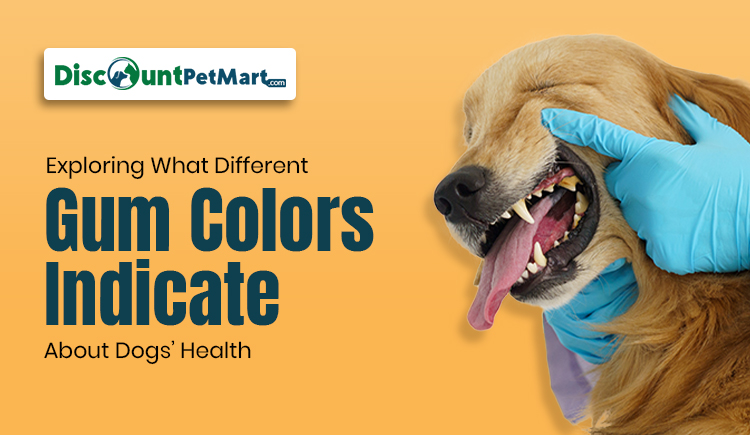What It Reveals About Your Pet’s Health Leave a comment
When we talk about gum health in dogs, it is not just about their cuddle-worthy, pretty smile. A dog’s good oral health is an important indicator of their overall well-being. Similarly, teeth or gums in bad shape can be a sign of an underlying disease. That’s why it is important you inspect your furry companion’s mouth regularly. But, how do you recognize if there is anything wrong? Well, a dog gum color says a lot about their health condition. Once you learn to decode the gum color, it will be easier to get an idea about the underlying problem and maintain your dogs gum health.
Read on to learn about what different gum colors in dogs indicate and how you can keep your dog’s gums healthy.
Color & texture of healthy gums in dogs
Ideally, your dog’s gums are considered healthy if they have a bubblegum-pink or uncooked salmon-like color. The pink color suggests proper blood circulation and oxygenation. However, dogs of certain breeds have dark gums and they can be considered healthy even if not pink. Your pooch’s gums should feel smooth and wet on touch. This is a sign that they are well hydrated. Further, the gums should turn white momentarily when you gently press them, but should come back to their normal pink within two seconds (it is called Capillary Refill Time- CRT) once you release the pressure.
If the above is not the case, your dog may be suffering from a health problem and it is time you take them to a veterinarian.
Different dog gum color and what they indicate
Here is what different gum colors mean about dog health:
Pale or white gums White or pale gums are of serious concern as this can be a signal of a lack of blood circulation or low red blood cells. It indicates anemia, heart disease or shock and needs immediate care.
Red or inflamed gums Red gums are a sign of gingivitis. Just inflamed or momentarily deep pink gums can be due to your fur buddy being excited or hot, and is not a cause for concern. But, prolonged cherry red color of the gums can be the result of carbon monoxide or other poisoning, heatstroke or hypertension.
Blue or purple gums Medically called cyanosis, this color indicates that an adequate amount of oxygen is not reaching your dog’s body. Your fur baby may be suffering from a heart disease, respiratory illness, or low blood pressure. This can be potentially life-threatening and require immediate medical attention.
Yellow gums Yellow gums often indicate immune-mediated anemia or liver dysfunction, jaundice or icterus. Another reason can be damage to red blood cells. Your fur friend can also get yellow gums as a side effect of blood transfusions.
Dark spots There can be multiple reasons for brown or black patches on the gums, including aging, infection, or an autoimmune disorder. The spots that have always been there can be a breed-specific feature. But the ones that have newly appeared need a vet check-up.
How to keep dogs’ gums healthy
It goes without saying that your furry family member will require disease-specific care once you have identified it with the help of gum appearance. But to maintain your pooch’s oral health and keep their gum healthy, the following tips will be helpful:
Brush your pet’s teeth regularly. It helps keep teeth clean, reduce plaque and tartar formation and prevent infections. Brushing also allows you to take a good look at your pet’s mouth and find out the abnormalities, if any, early.
Take your fur friend for regular professional dental cleaning. You may be taking good care of their teeth, but a vet ensures deep and thorough cleaning, thus reducing the chances of the development of any dental disease.
Provide a nutritionally-balanced diet to your fur friend that is free from nasties, like sugar. Healthy food helps keep your dog in the best of health.
Add dental treats to your dog’s diet. The crunchy treats help scrape plaque and tartar and provide the chewing exercise for healthy teeth and gums.
Frequently asked questions
It is natural for dog parents to be curious about the oral health of their beloved pet. In addition to the aforementioned information, here are answers to some of the most common questions pet parents may have regarding dental health in dogs:
What are the common gum problems dogs suffer from?
Some of the most common gum problems in dogs include:
Gum recession: A condition where gums recede and expose the roots of the teeth, causing sensitivity and tooth loss.
Gum bleeding: Dogs experience bleeding from the gums while eating or brushing, mostly due to inflammation or infection.
Gingivitis: Inflammation of the gums due to plaque and tartar build-up.
Periodontitis: It is an advanced stage of gum disease, which includes inflammation of the structure (bone & gums) that supports teeth.
Stomatitis: A dental condition that causes inflammation of the gums and mucus membranes.
What are the signs of compromised gum health other than their color?
The other signs of unhealthy gums include bad breath, growths, ulceration, broken teeth, etc. Take your dog to your veterinarian for a check-up and treatment if you observe these symptoms.
Does my dog’s diet affect their gum health?
A big yes. Diet impacts every part of your dog’s body. A nutrition-rich diet helps maintain your dog’s overall health. Ensure you include food that is rich in vitamins C & E and low in sugar in your fur baby’s diet to maintain their gum health.
In the end
A dog gum color is a prominent indicator of any underlying health conditions they are suffering from. Regular examination of your furry family member’s mouth helps you identify and treat the disease they may have developed. Besides, regular oral care goes a long way in keeping your pooch’s gum health in check and maintaining their overall well-being.

